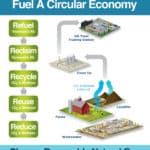Renewable Natural Gas: Abundant Waste Sources Fuel A Circular Economy
Renewable Natural Gas (RNG) is made from biogases derived from Agriculture, Wastewater Treatment, Landfills and Organic Food Waste. Those sources mean that the materials needed to make RNG are nearly boundless. The biogas is typically captured on-site with organic waste being added to an oxygen-free, temperature controlled environment, such as an anaerobic digester tank.
Naturally occurring bacteria breaks down the organic waste and raw biogas is the byproduct of the digestion process. Biogas is primarily methane but can contain up to 25% to 50% of carbon dioxide as well as small amounts of other contaminant gases. This resulting biogas is not high enough quality to be used as fuel so the biogas must be purified.
The raw biogas is transferred to a biogas upgrader facility for the purification process. The process removes carbon dioxide, hydrogen sulfide, water and other contaminant gases through various methods of scrubbing, adsorption and treatment. The purified biogas is called biomethane and can be used interchangeably with geologic natural gas. The biomethane is then ported into existing pipeline, transport and storage systems to fuel our fleets.
And that’s how renewable natural gas is made!
Reduce. Reuse. Recyle. Reclaim. Refuel. Choose Renewable Natural Gas. #CleanFleetMonth

